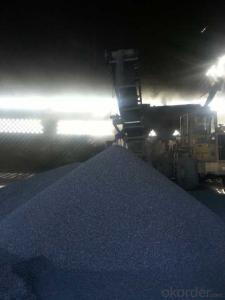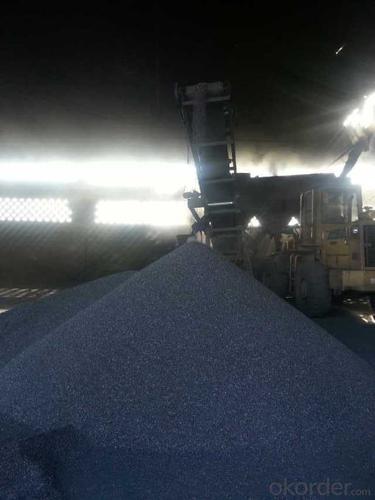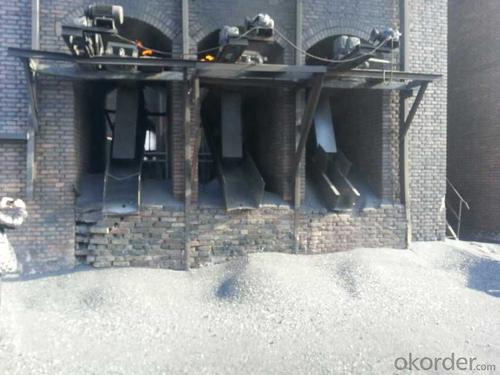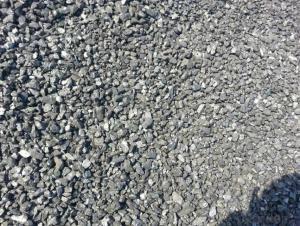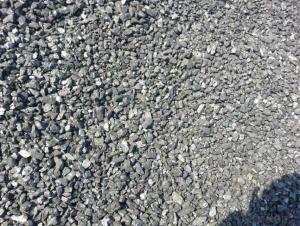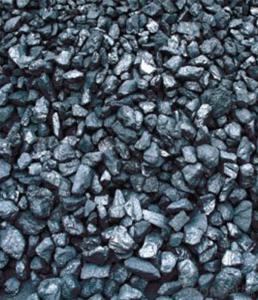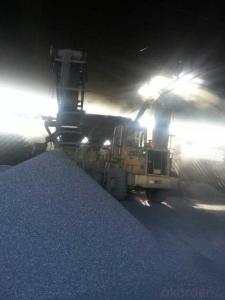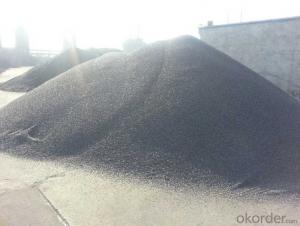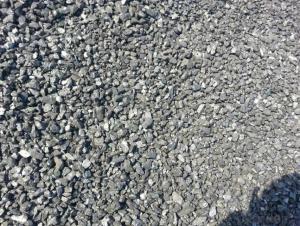Injection Carbon FC85 for Australia Market
- Loading Port:
- Tianjin
- Payment Terms:
- TT OR LC
- Min Order Qty:
- 20 m.t.
- Supply Capability:
- 5000 m.t./month
OKorder Service Pledge
OKorder Financial Service
You Might Also Like
Packaging & Delivery
Injection Carbon FC85 for Australia Market
25kgs/50kgs/1ton per bag or as buyer's request
Specifications
Injection Carbon FC85 for Australia Market
Calcined Anthracite
Fixed carbon: 90%-95%
S: 0.5% max
Size: 0-3. 3-5.3-15 or as request
Advantage and competitive of caclined anthracite:
Injection Carbon FC85 for Australia Market
1. strong supply capability
2. fast transportation
3. lower and reasonable price for your reference
4.low sulphur, low ash
5.fixed carbon:95% -90%
6..sulphur:lower than 0.3%
General Specification of Calcined Anthracite:
Injection Carbon FC85 for Australia Market
| FC | 90 | 88 | 85 | 83 | 82 |
| ASH | 8.5 | 10 | 12 | 14 | 15 |
| V.M. | 1.5 | 2 | 3 | 3 | 3 |
| S | 0.35 | 0.5 | 0.5 | 0.5 | 0.5 |
| MOISTURE | 0.5 | 1 | 1 | 1 | 1 |
Pictures
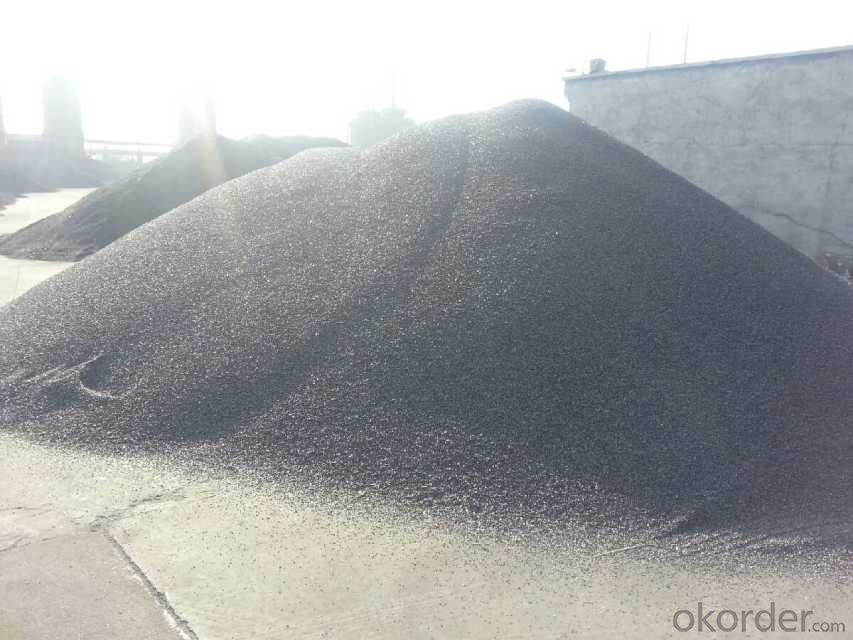
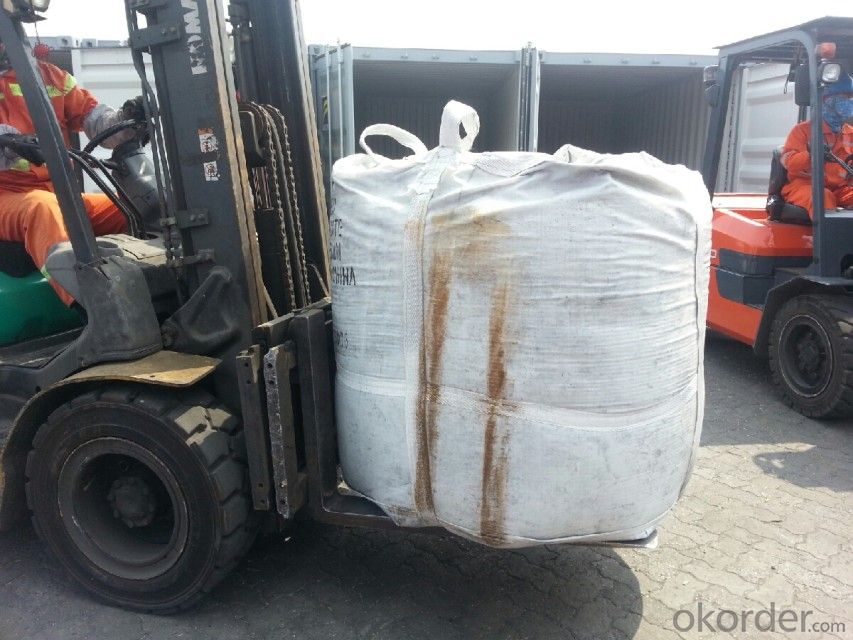
Injection Carbon FC85 for Australia Market
Advantage:
1.High quality and competitive price.
2.Timely delivery.
3.If any item you like. Please contact us.
Your sincere inquiries are typically answered within 24 hours.
- Q: What are the effects of ocean acidification on marine life?
- The detrimental effects of ocean acidification on marine life are substantial. The primary reason for this phenomenon is the rise in carbon dioxide (CO2) emissions, which the oceans absorb and cause a decrease in pH levels. This increasing acidity has profound consequences for a variety of marine organisms and ecosystems. Shell-forming organisms, such as corals, mollusks, and certain plankton, are among the most vulnerable groups affected by ocean acidification. The acidity reduces the availability of carbonate ions, which are crucial for these organisms to construct and upkeep their shells or skeletons. Consequently, their growth and development are hindered, making them more susceptible to predation and extinction. This not only impacts these specific species but also disrupts the entire food chain since they serve as a vital food source for numerous other marine organisms. Moreover, ocean acidification has negative effects on the physiology and behavior of various marine organisms. Research has indicated that it can impair the ability of fish to detect predators, find food, and navigate, leading to decreased survival rates and modified migratory patterns. Additionally, acidification can disrupt reproductive processes, such as the growth and survival of fish larvae, resulting in population declines and reduced biodiversity. Coral reefs, often referred to as the "rainforests of the sea," are especially susceptible to ocean acidification. The increased acidity hampers the calcification process necessary for coral growth, making them more prone to bleaching and death. As coral reefs provide essential habitats for numerous marine species, their decline would have a cascading impact on the entire ecosystem. Lastly, ocean acidification also affects the equilibrium of marine ecosystems by changing the composition and abundance of various species. Some organisms, like certain types of algae, may actually benefit from elevated CO2 levels and thrive, causing an imbalance in the ecosystem. This can result in the dominance of specific species, negatively impacting overall biodiversity and the stability of the marine environment. In conclusion, ocean acidification presents significant dangers to marine life. It disrupts the growth and development of shell-forming organisms, impairs the physiology and behavior of various marine species, damages coral reefs, and alters the composition of marine ecosystems. Addressing this issue is crucial to safeguard marine biodiversity, sustain fisheries, and maintain the overall health of our oceans.
- Q: What are the properties of carbon fibers?
- Carbon fibers possess a range of remarkable attributes, rendering them a distinctive and adaptable material. One noteworthy characteristic is their exceptional strength-to-weight ratio. Carbon fibers exhibit tremendous strength, often surpassing that of steel, while also being significantly lighter. This quality makes them exceptionally well-suited for industries such as aerospace and automotive, where high strength and low weight are essential. Another significant attribute of carbon fibers is their stiffness. They possess a high degree of rigidity, ensuring minimal deformation when subjected to applied loads. This property proves advantageous in applications that require stability and rigidity, such as the construction of sporting goods like tennis rackets or golf clubs. Additionally, carbon fibers display outstanding resistance to chemical corrosion. They exhibit a high level of resistance to the detrimental effects of chemicals or corrosive substances, making them highly suitable for use in harsh environments. Industries such as chemistry or offshore structures prefer carbon fibers due to this property. Furthermore, carbon fibers have a low thermal expansion coefficient, indicating minimal expansion when exposed to heat. This characteristic is vital in applications where thermal stability is crucial, such as the manufacturing of high-temperature components like turbine blades or heat shields. Moreover, carbon fibers possess excellent fatigue resistance, enabling them to endure repeated loading and unloading cycles without significant damage. This attribute is particularly advantageous in applications subjected to cyclic or dynamic stresses, including the construction of sports equipment or aerospace structures. Lastly, carbon fibers exhibit excellent electrical conductivity. They efficiently conduct electricity, making them suitable for applications that require electrical conductivity, such as lightning strike protection in the aerospace industry or the production of electronic devices. In summary, the high strength-to-weight ratio, stiffness, chemical resistance, low thermal expansion, fatigue resistance, and electrical conductivity of carbon fibers establish them as a highly sought-after material in various industries.
- Q: How is carbon used in the production of lubricants?
- Carbon is used in the production of lubricants as it forms the base of many lubricant formulations. Carbon compounds, such as hydrocarbons, are used as the primary ingredient in lubricants to provide lubricating properties. These compounds help reduce friction and wear between moving parts, thus improving the efficiency and lifespan of machinery and equipment.
- Q: Does alumina react with carbon?
- NotThe smelting of Al in industry can only be done by electrolysis. Even at high temperatures, the reducibility of C is not as strong as Al, and the melting point of Al2O3 is very high. At this temperature, C has been gasified
- Q: Benefits of reducing carbon emissions
- The researchers then extracted 4 ice ages from 500 to 140 thousand years from Greenland, which resulted in the discovery of TOMV virus in the ice. Researchers say the surface of the virus is surrounded by solid proteins, so it can survive in adversity.The new findings that researchers believe that a series of influenza, polio and smallpox epidemic virus may be hidden in the depths of the ice, the human of the original virus had no ability to resist, when global temperatures rise to ice melting, the ice buried virus in the thousand or more may be raised, forming the epidemic. The scientists said, although they do not know the survival of the virus of hope, or the opportunity to re adapt to the ground environment, but the possibility certainly can not deny the virus back.
- Q: How are carbon compounds classified?
- Carbon compounds can be categorized according to the type and number of atoms bonded to carbon atoms. There are various types of carbon compounds, including hydrocarbons, alcohols, aldehydes, ketones, carboxylic acids, esters, ethers, amines, amides, and more. Hydrocarbons are carbon compounds solely consisting of carbon and hydrogen atoms. They can be further divided into two main groups: aliphatic hydrocarbons and aromatic hydrocarbons. Aliphatic hydrocarbons include alkanes, alkenes, and alkynes, which are classified based on the carbon-carbon bonds they possess. On the other hand, aromatic hydrocarbons have a ring structure and are known for their aromaticity. Alcohols are carbon compounds with a hydroxyl (-OH) group attached to a carbon atom. They are categorized based on the number of hydroxyl groups connected to the carbon atom. For instance, methanol is a monohydroxy alcohol, while ethylene glycol is a dihydroxy alcohol. Aldehydes and ketones are carbon compounds containing a carbonyl group (C=O). Aldehydes have the carbonyl group attached to a terminal carbon atom, whereas ketones have it attached to an internal carbon atom. Their names are determined by the number and position of the carbonyl group within the molecule. Carboxylic acids are carbon compounds with a carboxyl group (-COOH). They are named by replacing the -e ending of the corresponding hydrocarbon with -oic acid. For example, methane becomes methanoic acid. Esters are carbon compounds derived from the reaction between a carboxylic acid and an alcohol. They have the general formula RCOOR’, where R and R’ can represent any alkyl or aryl group. Often, they are named based on the alcohol and acid used in their formation. Ethers are carbon compounds in which an oxygen atom is bonded to two alkyl or aryl groups. Their names are formed by listing the alkyl or aryl groups in alphabetical order followed by the word "ether". Amines are carbon compounds with a nitrogen atom bonded to one or more alkyl or aryl groups. They are named by adding the suffix -amine to the name of the alkyl or aryl group attached to the nitrogen atom. Amides are carbon compounds with a carbonyl group (C=O) bonded to a nitrogen atom. They are named by replacing the -oic acid or -ic acid endings of the corresponding carboxylic acid with -amide. In summary, the classification of carbon compounds is based on their functional groups and the arrangement of atoms surrounding the carbon atom. These classifications aid in categorizing and studying the diverse range of carbon compounds found in nature and synthesized in laboratories.
- Q: How does carbon impact the ozone layer?
- Carbon does not directly impact the ozone layer. However, carbon compounds such as chlorofluorocarbons (CFCs), which contain carbon, can have a significant impact on the ozone layer. When released into the atmosphere, CFCs can reach the stratosphere where they are broken down by ultraviolet (UV) radiation and release chlorine atoms. These chlorine atoms then catalytically destroy ozone molecules, leading to the depletion of the ozone layer. The destruction of the ozone layer is a critical environmental issue as it allows more harmful UV radiation from the sun to reach the Earth's surface. Increased UV radiation can have detrimental effects on human health, including skin cancer, cataracts, and weakened immune systems. It can also harm ecosystems by damaging phytoplankton, which are crucial for the marine food chain, and affecting the growth of plants and crops. To combat this problem, the international community has taken steps to reduce the production and use of ozone-depleting substances, including CFCs. The Montreal Protocol, an international environmental agreement, has been successful in phasing out the production of CFCs and other harmful substances. This has contributed to the recovery of the ozone layer, although it is still a long-term process. In conclusion, carbon itself does not directly impact the ozone layer. However, carbon compounds like CFCs, which are released into the atmosphere, can lead to the destruction of the ozone layer. Efforts to reduce the production and use of these ozone-depleting substances have been crucial in protecting the ozone layer and mitigating the harmful effects of increased UV radiation.
- Q: What kinds of carbon black paper do you have?
- Classification of weights:Carbon free carbon paper has 45g/m2CB paper, 47g/m2CF paper and 52g/m2CFB paper according to quantitative. Carbon free carbon paper is divided into 80 parts: 48, 50 and 80: 52: below: 47 and 2.55-60 grams for office reports, receipts, delivery orders, delivery lists, etc..Two. Classification of specifications:Carbon free carbon paper can be divided into web (rools) and paperboard (sheets) according to specifications. The width of the web can range from 160mm to 1940mm, and the size of the flat paper can range from 420mm*530mm to 1420mm*1420mm.
- Q: What is carbon nanophotonics?
- The study and manipulation of light at the nanoscale using carbon-based materials is known as carbon nanophotonics. This branch of science and technology integrates carbon nanotubes, graphene, and diamond nanoparticles with photonics to develop new optical devices and systems. Carbon-based nanomaterials possess exceptional electrical conductivity, high mechanical strength, and excellent optical properties, making them ideal for nanophotonics applications. These materials can confine and manipulate light at the nanoscale, enabling the miniaturization of optical components and enhancing light-matter interactions. Carbon nanophotonics has vast potential across various fields. Telecommunications, for instance, can benefit from high-speed and compact photonic devices developed using carbon nanomaterials for efficient data transmission. In the field of sensing, highly sensitive and selective sensors can be developed using carbon nanophotonics to detect different molecules and substances. Furthermore, carbon nanomaterials can enhance the efficiency of solar cells and other photovoltaic devices, contributing to advancements in energy harvesting. In summary, carbon nanophotonics is a rapidly evolving field that combines carbon-based nanomaterials with photonics to create innovative optical technologies. By harnessing the power of light at the nanoscale, this field has the potential to revolutionize industries and drive advancements in science and technology.
- Q: How does carbon impact the availability of clean energy solutions?
- The availability of clean energy solutions is significantly affected by carbon. Climate change, caused mainly by carbon emissions from burning fossil fuels and human activities, poses a serious threat to the environment and human well-being. Therefore, there is an urgent need to transition to cleaner energy sources that emit less carbon. Clean energy solutions, such as solar and wind power, have the potential to greatly reduce carbon emissions. These energy sources generate electricity without burning fossil fuels, resulting in minimal to no carbon emissions. By replacing traditional energy sources with clean alternatives, we can decrease our carbon footprint and mitigate climate change. However, the presence of carbon emissions impacts the availability and scalability of clean energy solutions in multiple ways. Firstly, the continued dependence on carbon-intensive energy sources, like coal and oil, hampers the rapid adoption of clean energy technologies. The existing infrastructure and investments in fossil fuel-based energy systems make it challenging to transition to clean alternatives. Secondly, carbon emissions contribute to global warming, which affects the availability and efficiency of certain clean energy solutions. For instance, higher temperatures can decrease the effectiveness of solar panels and affect the output of hydropower due to changes in rainfall patterns. This emphasizes the significance of reducing carbon emissions to ensure the long-term viability and efficacy of clean energy technologies. Moreover, carbon emissions have economic implications that can influence the availability of clean energy solutions. Governments and policymakers play a crucial role in encouraging the adoption of clean energy through regulations, subsidies, and carbon pricing mechanisms. These policies can impact the affordability and accessibility of clean energy technologies, making them more appealing to investors and consumers. In conclusion, carbon emissions have a profound impact on the availability of clean energy solutions. By reducing carbon emissions and transitioning to cleaner energy sources, we can mitigate climate change, enhance the efficiency of clean energy technologies, and create a more sustainable future. It is crucial for governments, businesses, and individuals to prioritize the development and adoption of clean energy solutions to ensure a cleaner and healthier planet for future generations.
Send your message to us
Injection Carbon FC85 for Australia Market
- Loading Port:
- Tianjin
- Payment Terms:
- TT OR LC
- Min Order Qty:
- 20 m.t.
- Supply Capability:
- 5000 m.t./month
OKorder Service Pledge
OKorder Financial Service
Similar products
Hot products
Hot Searches
Related keywords
